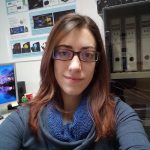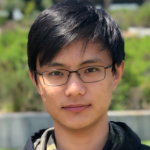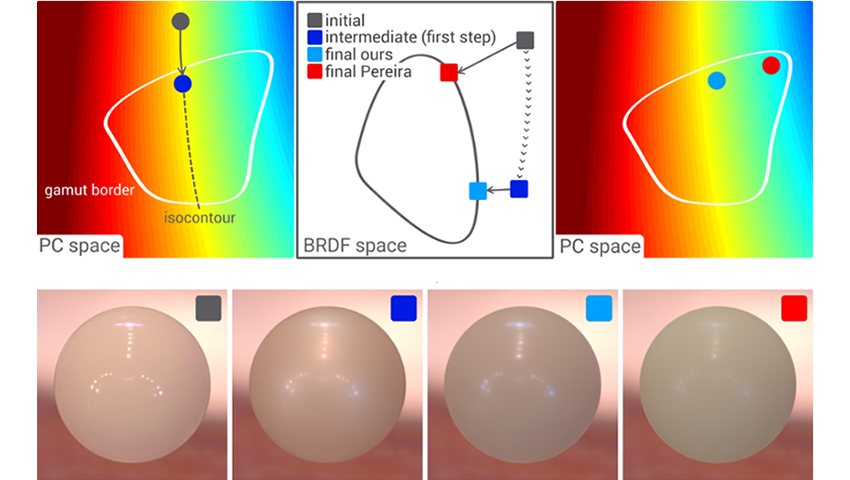In partnership with Microsoft, the ACM Student Research Competition — presented annually at the North American SIGGRAPH conference — is a unique forum for undergraduate and graduate students to present their original research before a panel of judges and attendees. Each year first-, second-, and third-place winners are chosen in both undergraduate and graduate research categories.
For a peek inside the program, we caught up with SIGGRAPH 2017 first-place undergraduate winners Tiancheng Sun and Ana Serrano to learn about their experiences. Stay tuned to news from SIGGRAPH 2018 for more on this summer’s competition and the related Posters program, which is receiving submissions through 10 May 2018.
Keep pushing, even when things don’t appear to progress. It is sometimes hard to see your progress when you are surrounded by so many great professionals and researchers, but it is definitely there. It is a very competitive field, but it has many great opportunities for development. A nice thing about computer graphics is that most of the time your research or work produces very visual results, so it is very rewarding in that sense.
—Ana Serrano, ACM SIGGRAPH Student Research Competition undergraduate winner
SIGGRAPH: Your winning project was titled “Attribute-preserving gamut mapping of measured BRDFs.” Tell us a bit about the project.
Tiancheng Sun (TS): I did this project when I was doing my research internship at the University of Zaragoza during the summer of 2016. This project is about bidirectional reflectance distribution function (BRDF) gamut mapping. In recent years, a technology has emerged that can directly print novel materials on the paper with standard printers. However, the printable materials are limited due to the small number of inks in the printer. In order to print an arbitrary material (BRDF), we wanted to find the most similar material in the printable set. Mathematically speaking, we wanted to present an arbitrary BRDF using a linear combination of BRDFs from a limited set, while still preserving its appearance as much as possible.
Ana Serrano (AS): We presented a novel gamut mapping algorithm for captured materials that focuses on preserving perceptual attributes (such as brightness or roughness), and minimizes the perceived distortions introduced during the mapping process.
Conveying materials with realistic appearance is still an open problem in computer graphics. In particular, the issue that we were interested in addressing during our project is that even if we accurately capture a material, it is hard to reproduce it faithfully. Devices such as screens, 2D printers, or 3D printers have a limited subset or gamut of appearances that they are able to reproduce due to their physical limitations (for the case of printers, this is a limited amount of inks).
To put gamut limitations simply, imagine we have yellow and red inks, and we want to print something blue. It is not possible to accurately produce a blue color from only those two inks. We would need to somehow try to combine those two inks to produce something as close to blue as possible. This gets more complicated if we have more inks, and if we need to reproduce more complex colors and appearances.
Given that it is not possible to perfectly reproduce complex appearance from only a subset of inks, the problem that gamut mapping tries to address is to find the best combination of inks to minimize changes in appearance when printing such materials. The key point to solve this problem is to define a good distance metric to tell us how far the desired measured appearance is from the one we can actually print, in order to try to minimize that distance so they look as similar as possible.
Previous works have tried to define this metric directly over the measured appearance, or with the distance between pixel values in image space. We go further by proposing to use as a distance metric the perceptual appearance of the material. With this, we try to minimize the distortions on the overall appearance of the material that are actually perceived by users.
SIGGRAPH: Share your favorite story from the research gathering process.
TS: This project is one of my first research-oriented projects. When I was working on this project, I was still wondering whether I should continue doing research or just start working after college. However, one thing happened during this project that made me feel I should definitely apply for a Ph.D. afterwards. After a long week of coding and debugging, I found myself still testing my algorithm in the lab on a weekend. I had been working on the algorithm for a couple weeks at that point, but hadn’t visualized the results yet. But at the end of that day, after I finally visualized the final results, I realized that our algorithm worked very well and even better than the current state-of-the-art. At that moment, I just got so excited: I rushed out from the lab, and jumped up and down in the corridor. I feel that is the best feeling in the world: After a long time of gloom, you finally reach the light. Although afterward, I began to understand that research is not only about good results, but also about thorough evaluations and good stories. I still think that the kind of excitement of exploring new things is the biggest motivation for me to do research.
AS: One of my favorite stories is actually related to this project. We started working on it, and for a while, we were not explicitly including perception in the loop. Results were nice, but we felt something was missing. Just a couple weeks before the deadline, we included another step to the algorithm (that would be the first step in our two-step mapping algorithm) that was based on a previous project where we mapped captured materials to perceptual attributes. That was the missing piece, and our results were great with that addition, but there was just a few days until the deadline. It was very stressful and a lot of work to put together all the results of our project after changing the algorithm just a few days from the deadline, but it was worth it.
SIGGRAPH: What is your best advice for someone pursuing a career in the science of computer graphics?
TS: Now, I still feel that I’m just a newbie in computer graphics, so I don’t know whether my advice is good or not. With that said, I think that if someone wants to do some contributions to graphics, one should try to focus on one specific area, and devote a lot of time and effort to that. Due to the rapid development of computer science, nowadays, big contributions are not that easy to accomplish. One should work very hard and be really patient on the research in order to achieve good results.
AS: Keep pushing, even when things don’t appear to progress. It is sometimes hard to see your progress when you are surrounded by so many great professionals and researchers, but it is definitely there. It is a very competitive field, but it has many great opportunities for development. A nice thing about computer graphics is that most of the time your research or work produces very visual results, so it is very rewarding in that sense.
SIGGRAPH: Share what has happened with your research since it was presented at SIGGRAPH.
TS: Unfortunately, I didn’t get chance to present our work at SIGGRAPH, due to an administrative processing of my U.S. visa. But I did feel that our work got more exposure after it was presented at SIGGRAPH. There were more and more people asking me about the project. I got chance to discuss with more people interested in this topic, and got a lot of interesting ideas that can be investigated more.
AS: Our project was accepted as a full paper in the EGSR (Eurographics Symposium on Rendering) conference, and was published in the Computer Graphics Forum. We have also shared our work at many small (local) conferences not specializing in computer graphics. We really like to present this work because it is very visual, and we are very proud of our results. It addresses a problem that many people have suffered from in real life (e.g., when trying to print a picture), so it is easier to explain what is the purpose of the project. For future development of this project, we have some specific ideas on how to improve our results and make the whole process more intuitive, but we have not had the chance to implement them yet.
SIGGRAPH: How do you think winning a SIGGRAPH award will affect your career post-graduation?
TS: I think this is a great honor to me and a recognition of my research skills. This gives me more confidence to perform better in my graduate life.
AS: I think that this award may serve as an indicator of the quality of our research. This is a very competitive field, and this kind of award can help you stand out.
SIGGRAPH: Since SIGGRAPH, what has been your most exciting career accomplishment and why?
TS: I think, for me, the most exciting accomplishment is the current project I’m doing. I’m now doing a very fundamental project about BRDFs and we do have some good solutions for some long-troubled problems in graphics. We’re planning to make a full paper submission to SIGGRAPH Asia.
AS: This year, my research on virtual reality content generation has been awarded with the Nvidia Graduate Fellowship. This fellowship will help me further my research, and I am very excited about it.
 Ana Serrano is a Ph.D. candidate in the Graphics and Imaging Lab (Computer Science department) at Universidad de Zaragoza, Spain. She is mentored by Prof. Diego Gutierrez and Prof. Belen Masia. During the course of her Ph.D., she has interned with the Adobe Creative Technologies Lab, the Stanford Computational Imaging Group, and the Max-Planck Computer Graphics Group. Ana’s research spans several areas of visual computing. Currently, her main focus is to apply fundamental knowledge on human attentional behavior in order to overcome some of the current challenges of virtual reality (VR) video. Her research has been recently awarded with the Adobe Research Fellowship Honorable Mention and the Nvidia Graduate Fellowship.
Ana Serrano is a Ph.D. candidate in the Graphics and Imaging Lab (Computer Science department) at Universidad de Zaragoza, Spain. She is mentored by Prof. Diego Gutierrez and Prof. Belen Masia. During the course of her Ph.D., she has interned with the Adobe Creative Technologies Lab, the Stanford Computational Imaging Group, and the Max-Planck Computer Graphics Group. Ana’s research spans several areas of visual computing. Currently, her main focus is to apply fundamental knowledge on human attentional behavior in order to overcome some of the current challenges of virtual reality (VR) video. Her research has been recently awarded with the Adobe Research Fellowship Honorable Mention and the Nvidia Graduate Fellowship.
 Tiancheng (Kevin) Sun is a first-year Ph.D. student University of California, San Diego. His advisor is Prof. Ravi Ramamoorthi. Before joining UCSD, Sun completed his undergraduate study at Yao Class, Tsinghua University, which was found by ACM Turing Award laureate Andrew Yao. Sun had also worked as a research intern with Prof. Wolfgang Heidrich at King Abdullah University of Science and Technology. Sun’s winning project in ACM Student Research Competition (undergraduate) at SIGGRAPH 2017 was done during his research internship at University of Zaragoza with Prof. Diego Gutierrez and Belen Masia. Sun’s research interests lie in the area of photorealistic rendering, material modeling, and material acquisition and reconstruction. Currently, he’s working on BRDF modeling.
Tiancheng (Kevin) Sun is a first-year Ph.D. student University of California, San Diego. His advisor is Prof. Ravi Ramamoorthi. Before joining UCSD, Sun completed his undergraduate study at Yao Class, Tsinghua University, which was found by ACM Turing Award laureate Andrew Yao. Sun had also worked as a research intern with Prof. Wolfgang Heidrich at King Abdullah University of Science and Technology. Sun’s winning project in ACM Student Research Competition (undergraduate) at SIGGRAPH 2017 was done during his research internship at University of Zaragoza with Prof. Diego Gutierrez and Belen Masia. Sun’s research interests lie in the area of photorealistic rendering, material modeling, and material acquisition and reconstruction. Currently, he’s working on BRDF modeling.




